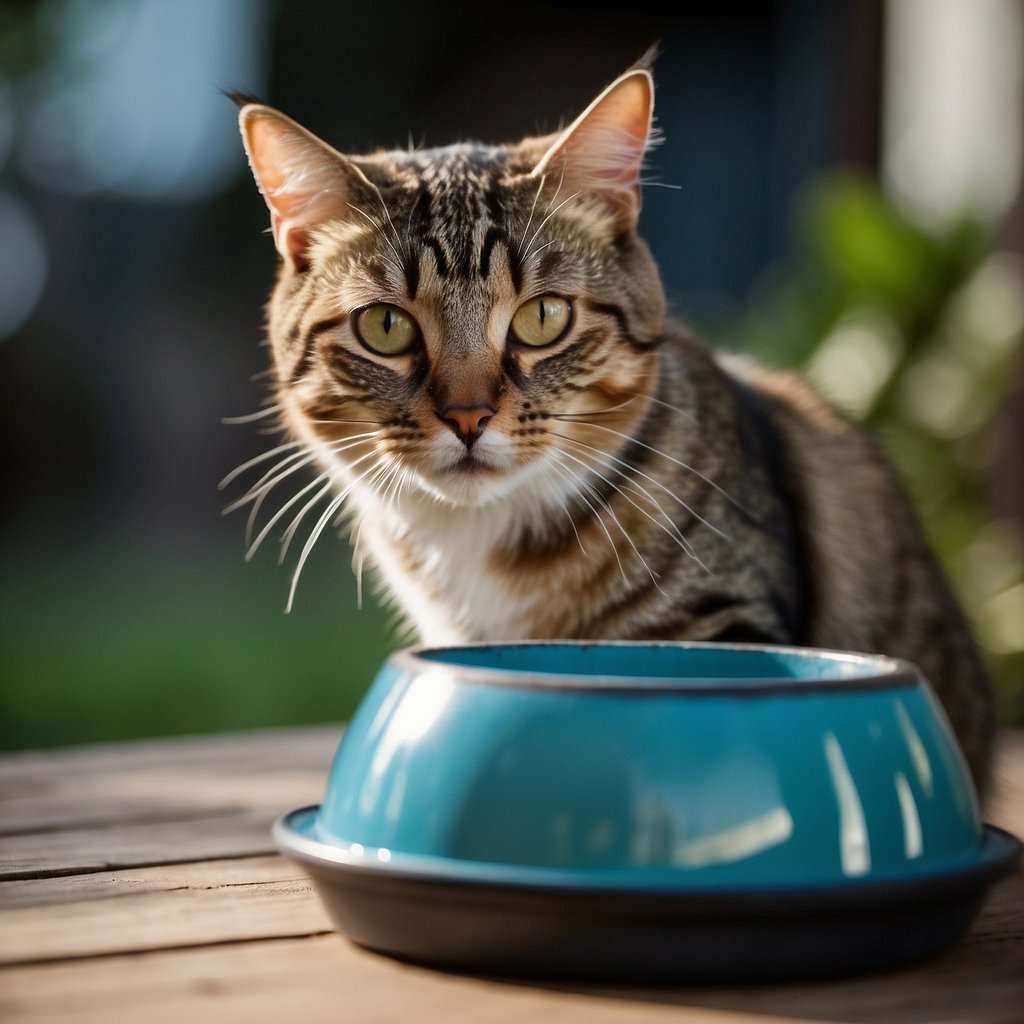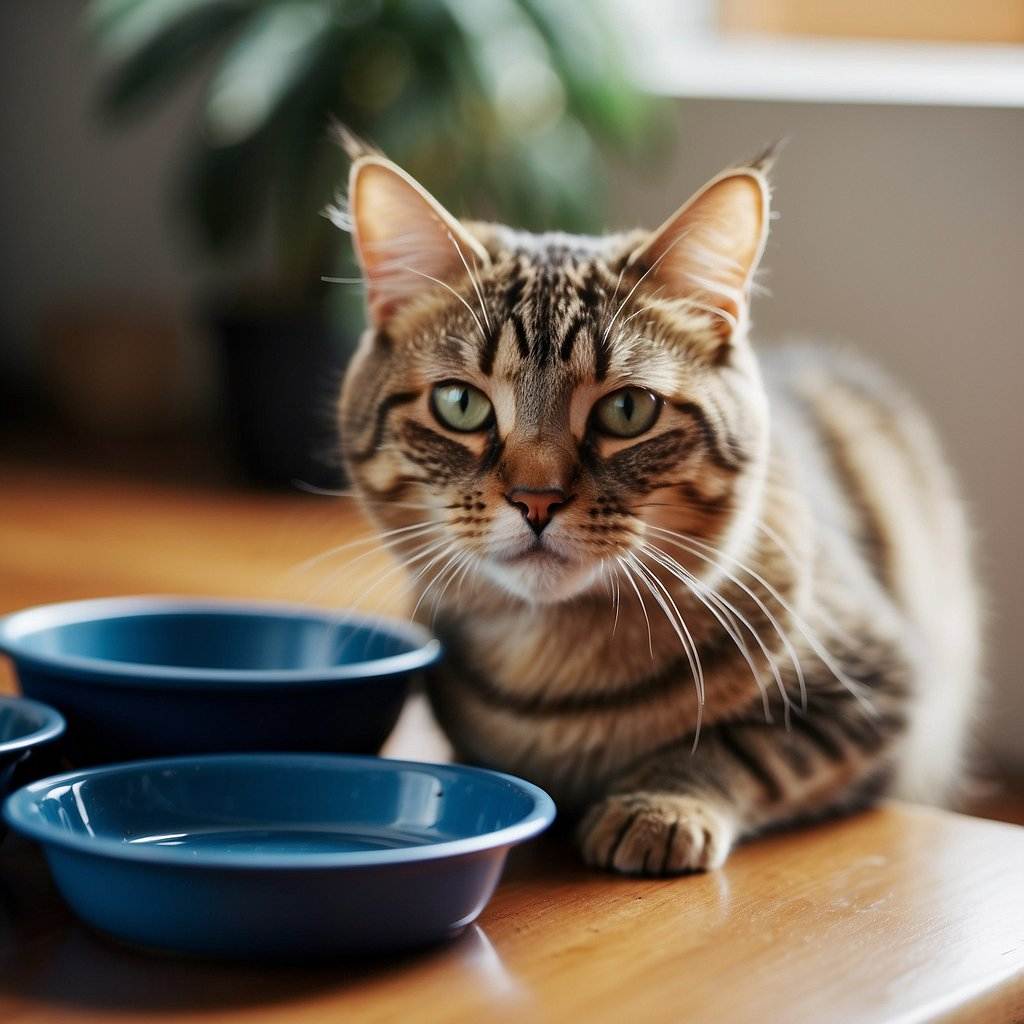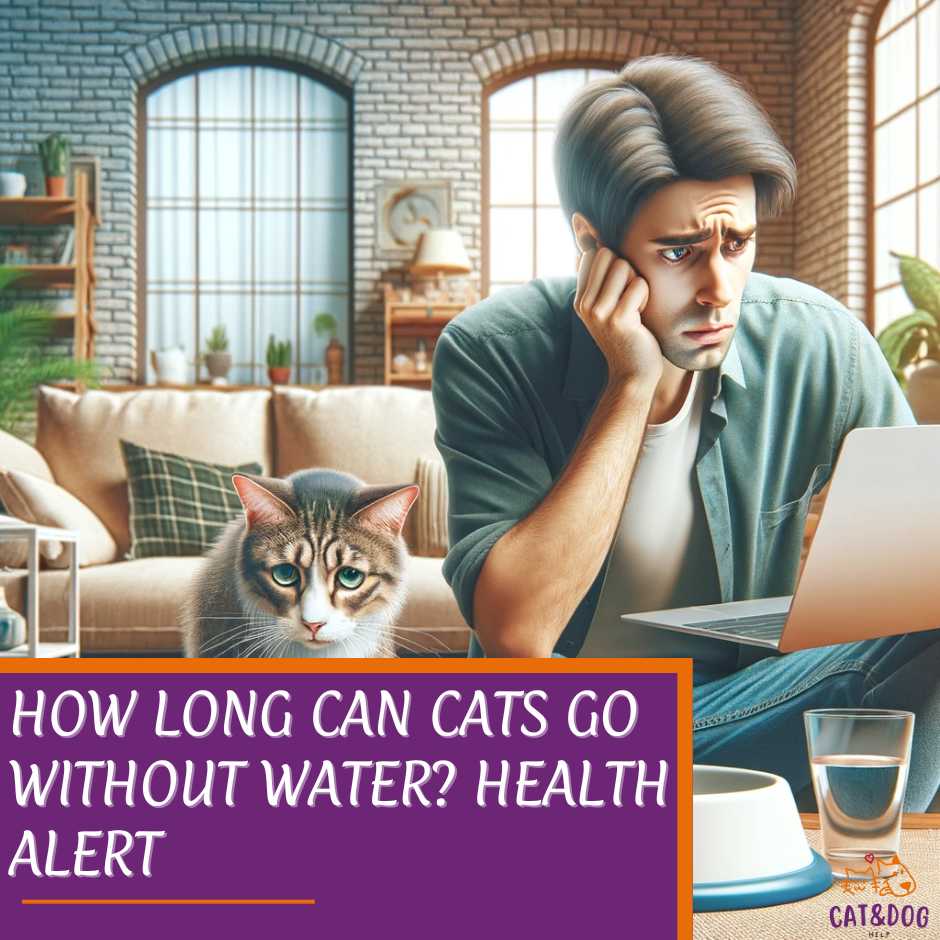Have you ever watched your cat and wondered just how much water they need to stay healthy and hydrated?
It might surprise you, but water is as crucial for your feline friend as it is for you. While cats seem to drink less frequently than their canine counterparts, the importance of water in their diet cannot be overstated.
As a responsible cat owner, it’s vital to know that cats cannot survive for more than three to four days without water, especially sick cats.
This critical piece of information is often overlooked, leading to common misconceptions about a cat’s hydration needs.
Cats are desert animals and are quite good at maintaining their hydration status with relatively little water, often derived from their food. This ability is why they produce a very concentrated—and smelly—urine.

Understanding your cat’s water requirements is fundamental to their well-being. Dehydration in older cats can onset quickly, sometimes in as little as 24 hours without water. That’s why food for older cats must be given great attention..
Recognizing the signs can save you and your feline friend from unnecessary distress.
This article sets the stage to delve deeply into the world of feline hydration, addressing the timeline for dehydration in cats, preventive measures you can take, and knowing when it’s time to seek help from your vet.
We aim to equip you with the knowledge to ensure that your older cats stay as sprightly, healthy, and hydrated as possible.
In particular, cats experiencing vomiting or diarrhea, or illnesses such as kidney failure or diabetes, can get dehydrated rapidly.
Key Takeaways
- Cats can’t survive beyond 3-4 days without water, underscoring the need for consistent hydration.
- Dehydration poses a significant risk and can occur within 24 hours of water deprivation.
- Understanding and monitoring your cat’s water intake are key to preventing health issues in cat.
How Long Can Cats Go Without Water?
Ever wondered how your feline friend manages to stay sleek and energetic?
It’s time to put the spotlight on water!
Water isn’t just for quenching thirst; it’s a vital player in your cat’s health. It’s like the engine oil that keeps their little bodies purring beautifully by:
- Regulating body temperature: Cats don’t sweat like we do, so they need water to cool down. (1)
- Aiding digestion: Got your cat on a top-tier gourmet diet? Water ensures that good food gets processed smoothly. (2)
- Eliminating waste: It’s like a mini-flush system, sweeping away the unwanted bits.
Now, you’re probably asking, “But how do cats get their water fix?” Here’s the scoop:
| Cats in the Wild | Domestic Cats |
| Rely on moisture from prey (yep, that’s where a chunk of their water intake comes from). | We need to fill up that bowl with fresh H2O. |
Your home-prowling panther might not be pouncing on prey, but they still aim for around 4 ounces of water per 5 pounds of lean body weight every day. (3)
For the math fans, that’s roughly 1 cup for a 10-pound cat daily!
Got your attention? Great, ’cause monitoring your cat’s water intake could be the difference between a healthy kitty and an emergency vet trip.
Remember, no water for more than 24 hours is a no-go; it leads to dehydration, and that’s dangerous territory.
Keep an eye out, top up that water bowl, and you’ll have one hydrated, happy kitty on your hands. It’s the purr-fect plan for your fluff ball’s well-being!
Factors Influencing Water Needs

Hey there, fellow cat enthusiast! Have you ever wondered how your furball manages its water needs? Well, let’s talk about diet first.
If you’re serving up wet food to your whiskered friend, you’re quenching their thirst quite a bit. Wet cat food, which contains up to 80% water, can provide a whopping 80% of their water intake. (4)
Neat, huh? On the flip side, dry food, such as kibble, is less hydrating, so if that’s on your kitty’s menu, they’ll need more water bowls around.
Now, onto health matters. Some feline friends have health conditions that can turn their water consumption needs upside up. (5)
For instance, cats dealing with renal disease or diabetes may feel the need to lap up more water than usual. It’s all about keeping things balanced, and these conditions can tip the scale. (6)
But hey, don’t get too worried. You’re already on the right track simply by learning these facts! Just keep an eye on your kitty’s water dish and chat with your vet if you think they’re not drinking enough.
After all, you and your vet are the dynamic duo your cat needs. Stay hydrated, friends!
Recognizing Dehydration in Cats
Have you noticed your feline friends aren’t as perky as they usually are? Dehydration in cats can sometimes slip under the radar since these independent creatures are experts at masking their discomfort. (7)
Being alert to the subtle changes can help you catch dehydration early and keep your kitty healthy and hydrated.
However, if you have noticed a sudden reduction in how much your cat is drinking or any signs of dehydration or illness, you should take them to see your veterinarian immediately.
But what about cats who are generally healthy, but just don’t seem to drink enough lot of water? Are there any long-term consequences of low water intake?
Signs and Symptoms
Watch out for these troubling tell-tale signs:
- Sunken eyes: This is a giveaway your cat needs water pronto!
- Lethargy: If they’re less playful and more ‘catnap,’ it’s a heads-up.
- Dry mouth: Peek inside. If their usual wet mouth is now dry, that’s a red flag.
Behavioral Changes Indicating Dehydration
Cats are mysterious, but their behaviors can reveal a lot:
- Decreased activity levels: Not jumping on their favorite perch anymore?
- Changes in drinking habits: Are they ignoring their water bowl or, conversely, sitting by it but not drinking? That’s concerning.
Remember, the clock is ticking once dehydration begins. Your cat may show signs within 24 hours of their last drink.
By day three or four, things could get pretty serious. So, keep that water bowl full and fresh to help your four-legged companion stay in tip-top shape!
You know your cat best, so if you suspect dehydration, don’t hesitate to reach out to your vet because they know and can solve your cat’s health issues. Quick action could nip this in the bud, so keep those whiskers twitching healthily!
And don’t forget, providing a constant source of clean water can’t be overstated.
Addressing the Hydration Timeline
Ever wondered just how long your fuzzy companion can last without a sip of water? Well, here’s the scoop: most cats can’t weave their nine lives past 3 to 4 days without hydration.
It’s not particularly a fun fact, yet essential to know. Your cat’s body is like a finely tuned engine, and water is its coolant that helps maintain the health and function of its internal organs.
So, understanding how long cats can go without water is crucial for their well-being.
Your kitty’s timeline can vary. Let’s unravel this:
- Kittens and Seniors: They’re like the delicate petals of your household; they need more frequent watering. Their little engines are either just getting started or have clocked a fair few miles.
- Health Status: Like us on a rough day, a cat with health issues might need extra care and more frequent water breaks.
- Active vs. Lazy Days: Has your cat been napping all day, or acting out their Tarzan fantasies? The more they play, the more they’ll need to lap up.
It’s a balancing act. Here’s a quick hydration cheat sheet for your pal:
| Age/Lifestyle | Water Needs |
| Kittens & Seniors | More frequent hydration checks |
| Health issues | Monitor closely; encourage water intake |
| High activity levels | Ready access to water; more is better |
Remember, this isn’t about being overbearing but ensuring a happy, hydrated cat. Keep that water bowl full and fresh – it’s your low-key love letter to your pet’s health.
And who doesn’t love staying perky and playful? So let’s keep those whiskers wet, and they’ll repay you with purrs and head bumps galore!
Preventive Measures and Solutions

Are you a cat parent? Keeping your feline friend hydrated might be trickier than you think! Cats aren’t huge on water slurping, so let’s make sure your cat is getting enough H2O.
Strategies to Prevent Dehydration
- Use Multiple Water Bowls: Did you know? Cats often prefer not to drink near their food. They’re quirky like that. Try spacing out water bowls around your home to encourage sipping.
- Quiet Please: Some cats are shy drinkers. Keep water bowls in low-traffic areas away from noise.
- Flowing Water Fascination: Ever noticed your kitty pawing at the tap? Cats love moving water! Consider setting up a cat water fountain to pique their interest.
- Stay Cool: Just like you, cats prefer cool, fresh water. So, swap out the water regularly. Ice cubes can be a fun treat, too!
| Tip | Why It Works |
| Multiple Bowls | Offers variety and convenience for your cat. |
| Water Away from Food | Mimics cats’ natural preference. |
| Fresh and Cool | Refreshing for cats increases water intake. |
Interactive Tools for Monitoring Hydration Fancy being a tech-savvy pet owner?
- Apps Ahoy: Keep tabs on your cat’s water intake with hydration-tracking apps. Just a few taps and you’re informed!
- Weigh the Water: Old-school but effective. Start the day by weighing the water bowl, and do it again at night to measure how much your kitty drank.
Remember, a cat’s “I’m thirsty” signals are subtle. Look out for a decrease in energy or dry gums. Your cat’s health is in your hands – or should we say paws?
Keep the water flowing and the good times rolling for your feline friend! 😺💧
When to Seek Veterinary Help
Wondering when it’s time to hurry to the vet? Let’s break down the signs and the actions to take to ensure your purring friend remains healthy and hydrated.
Early Signs of Dehydration:
- Dry gums
- Lethargy
- Sunken eyes
- Less frequent urination
If you notice any of these, it might be time to visit the vet. Cats are pretty good at hiding how they feel, so it’s crucial to catch these subtle hints early.
Serious Concerns Warranting Immediate Attention:
- Panting
- Rapid heart rate
- Skin that doesn’t snap back when pinched
- Any disorientation or collapse
Should these occur, don’t delay; call your vet immediately. Dehydration can rapidly become life-threatening, and every moment counts.
During regular check-ups, your vet can monitor your cat’s hydration and help manage any conditions that can complicate dehydration, like kidney disease or diabetes.
Especially if Spot is more of a sunbather than a water-sipper, these check-ups are invaluable—even if they’re just to give you peace of mind.
Remember, your feline friend counts on you to keep an eye out, so stay vigilant and ensure they get plenty of fresh water daily. When in doubt, a quick call to your friendly vet can clear up any concerns.
Keep your cat’s hydration on track, and they’ll thank you with purrs, and headbutts, and the good news is that you have options, even for the most stubborn, non-water-drinking cat!
If your cat is not freely drinking, you can try adding a small amount of low-sodium chicken broth or tuna juice to the water. This can help entice them to drink and stay hydrated.
Quick Recap

Hey there, cat lover! Wondering about your fuzzy friend’s hydration? Let’s quench your curiosity.
How much H2O does your kitty require? Your average-sized kitty needs around 7 to 8 ounces of water daily. But remember, if they munch on wet food, they’re sipping water too! (8)
Caught your cat turning up its nose at the water bowl? This could spell severe dehydration, and it can happen fast – in 24 hours without a drink.
Worried about dehydration? Look out for lethargy, dry mouth, or sunken eyes. And if it’s warm or your fur baby’s feeling under the weather, they’ll need more water to avoid sudden changes in their hydration levels.
When to ring up the vet? If it’s been a day without drinkies, it’s vet o’clock. Cats can be stealthy about their water intake but 3-4 days without water could be serious.
Here’s a quick hydration to-do list:
- Ensure clean water is always within the paw’s reach.
- Check-in on their drinking habits.
- When in doubt, a vet visit is the best shout!
Don’t forget that keeping your cat hydrated is a game of observation and loving care. Stay vigilant and keep those water bowls full and fresh. Happy hydrating!
Frequently Asked Questions
Water is essential for your cat’s health, and understanding hydration is key.
Below, I’ll answer some common questions about cats and their water needs, ensuring you are informed and equipped to support your furry friend.
What are the risks of a cat not drinking water for an extended period?
If your cat isn’t drinking enough water, they’re at risk of dehydration. Without water, your cat can only survive for about 3-4 days.
Dehydration can happen within 24 hours and is particularly dangerous, leading to kidney problems, and urinary issues, and can even be life-threatening.
Can certain foods help keep my cat hydrated?
Absolutely! Wet food can be a great source of hydration since it’s typically made up of about 70-80% water. This can complement their drinking habits, especially if your cat is more inclined to eat than drink.
Is tap water safe for cats, or should I use filtered/bottled water?
Tap water is usually safe for cats, but if you’re concerned about quality, filtered or bottled water can be an alternative.
If your local tap water is hard or contains high levels of chlorine, consider filtered water to protect your cat’s delicate system.
Can I train my cat to drink more water?
Yes, you can encourage your cat to drink more water.
Try placing multiple water bowls around your home, use a cat water fountain to stimulate interest, or even add water to their food.
These little tips can increase their water intake significantly.
Can I train my cat to drink more water?
Yes, you can encourage your cat to drink more water.
Try placing multiple water bowls around your home, use a cat water fountain to stimulate interest, or even add water to their food.
These little tips can increase their water intake significantly.
Can I train my cat to drink more water?
Yes, you can encourage your cat to drink more water.
Try placing multiple water bowls around your home, use a cat water fountain to stimulate interest, or even add water to their food.
These little tips can increase their water intake significantly.
Are there health risks associated with overhydration in cats?
Overhydration is rare in cats, but it can happen. It’s called water intoxication and can lead to issues such as electrolyte imbalances.
If you notice your cat is drinking excessive amounts of water, it could indicate a health problem, and you should consult a vet.
What measures should I take if my cat isn’t showing interest in drinking water?
If your cat is reluctant to drink water, try enticing them with a dripping faucet or a pet water fountain. Ensure the water is fresh and change it regularly.
If such measures don’t work, it’s essential to check with a vet, as lack of interest in water can sometimes signal a health issue.
However, there are some particular reasons why your cat avoids his water bowl, such as not seeking liquid refreshment like they do for food.
- The Ultimate Overview to Actual Cash Gambling Establishments - July 1, 2025


